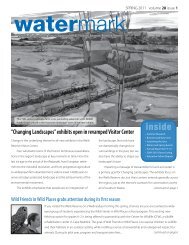Management Plan - National Estuarine Research Reserve System
Management Plan - National Estuarine Research Reserve System
Management Plan - National Estuarine Research Reserve System
You also want an ePaper? Increase the reach of your titles
YUMPU automatically turns print PDFs into web optimized ePapers that Google loves.
K–12 EducationThe Wells <strong>Reserve</strong> education programs targetingschoolchildren and youths are aligned, to theextent possible, with national science standardsand specific educational standards established bythe State of Maine. Maine Learning Results (Stateof Maine, 1997) are standards that express whatstudents should know and be able to do at variouscheckpoints during their education. LearningResults challenge communities, schools, and teachersto work together in implementing effectiveinstructional strategies to achieve high expectationsfor all students. The Education Coordinatorand Education Advisory Committee have identifiedMaine Learning Results associated with mostWells <strong>Reserve</strong> educational offerings.Field-and-Lab School ProgramsWater Quality Monitoring Field Studies Programwas launched as a natural outgrowth of theWatershed Evaluation Team (WET). This programprovides the experience of scientific work andintroduces teachers and students to the values ofwater quality monitoring. Participants collect watersamples, do laboratory analyses, discuss watershedissues, and view estuarine exhibits. This hands-onprogram includes a comprehensive Teacher Packetthat provides background information and activitiesfor use before and after school field trips.Figure IX.3. Taking a salinity reading.Figure IX.4. Students learning about ecology.The Education Department plans to integrate the<strong>System</strong> Wide Monitoring Program (SWMP) datawith this field trip program. <strong>Reserve</strong> educators willincorporate activities that use SWMP data into theTeacher Packet to familiarize teachers and studentsalike with SWMP, the NERR <strong>System</strong>, and creatingand interpreting graphical representations of data.The field trip program itself will evolve to includea guided visit to the Wells <strong>Reserve</strong>’s SeacoastWatershed Information Manager (SWIM) website,which links to the SWMP data. Visiting theSWIM website and using SWMP data during thisprogram will educate students and teachers aboutlocal resources for learning about and protectingcoastal watersheds.Microscopic Drifters is a plankton curriculum thatintroduces participants to the variety of planktonoccurring in the Gulf of Maine as well as toestuarine systems and food webs. It covers planktonidentification, life histories, seasonal populationfluctuations (and blooms, including red tides), bioluminescence,and other topics. Participants visitthe estuary to collect plankton samples and thenreturn to the teaching laboratory to view planktonwith dissection microscopes, learn from <strong>Reserve</strong>educators, and share their observations. MicroscopicDrifters leads to increased awareness of the importanceof plankton, greater knowledge of planktonecology, and greater appreciation for the intricateweb of life in the estuary and sea. This hands-onprogram includes a comprehensive Teacher Packet<strong>Management</strong> <strong>Plan</strong>: Education <strong>Plan</strong>71




